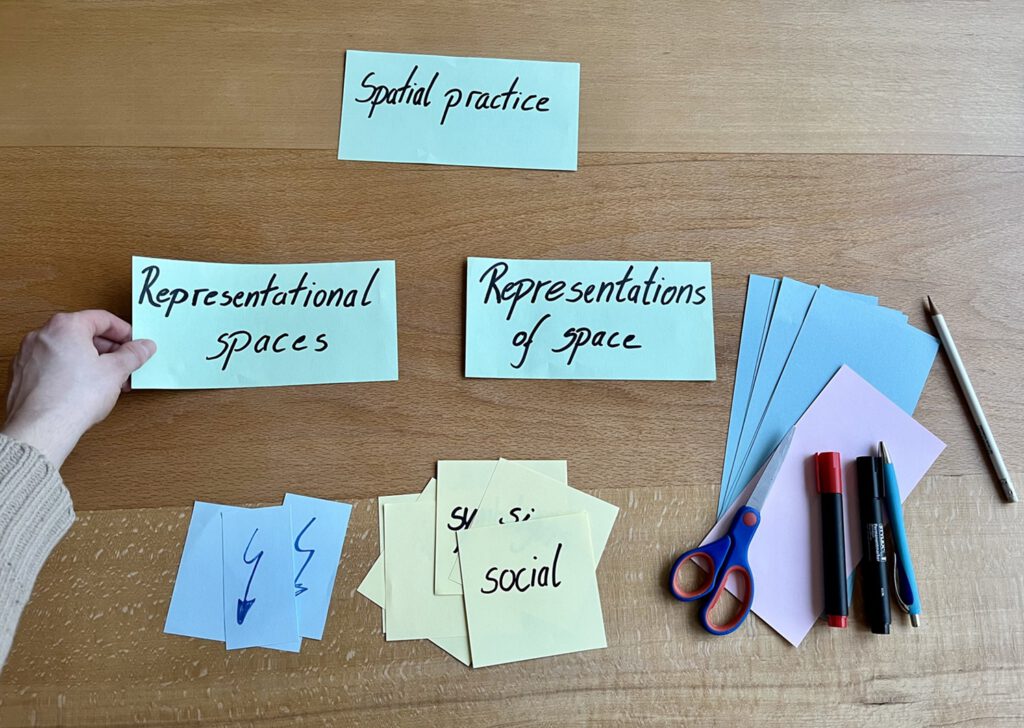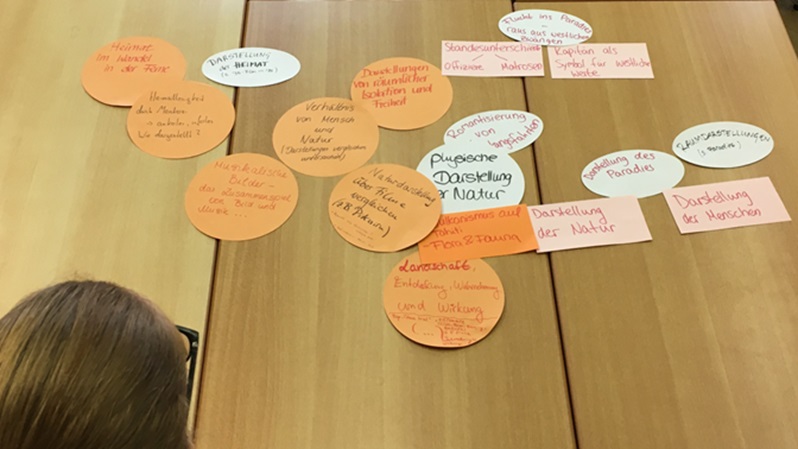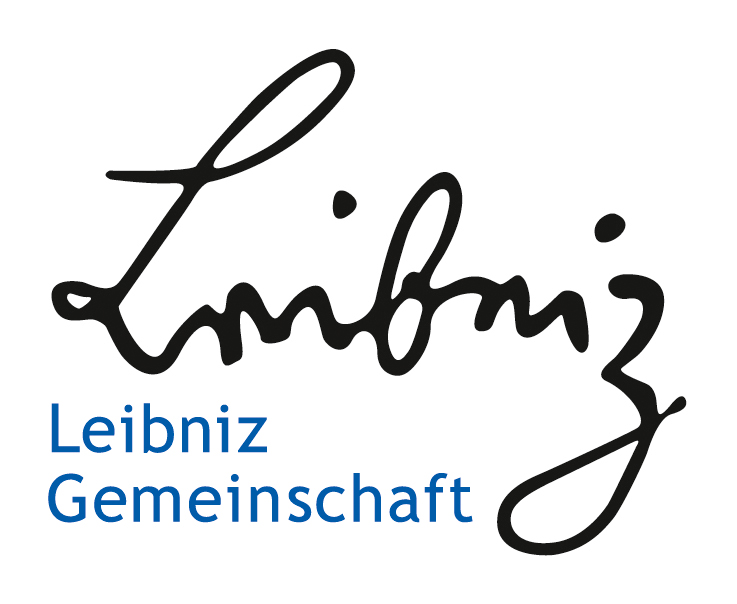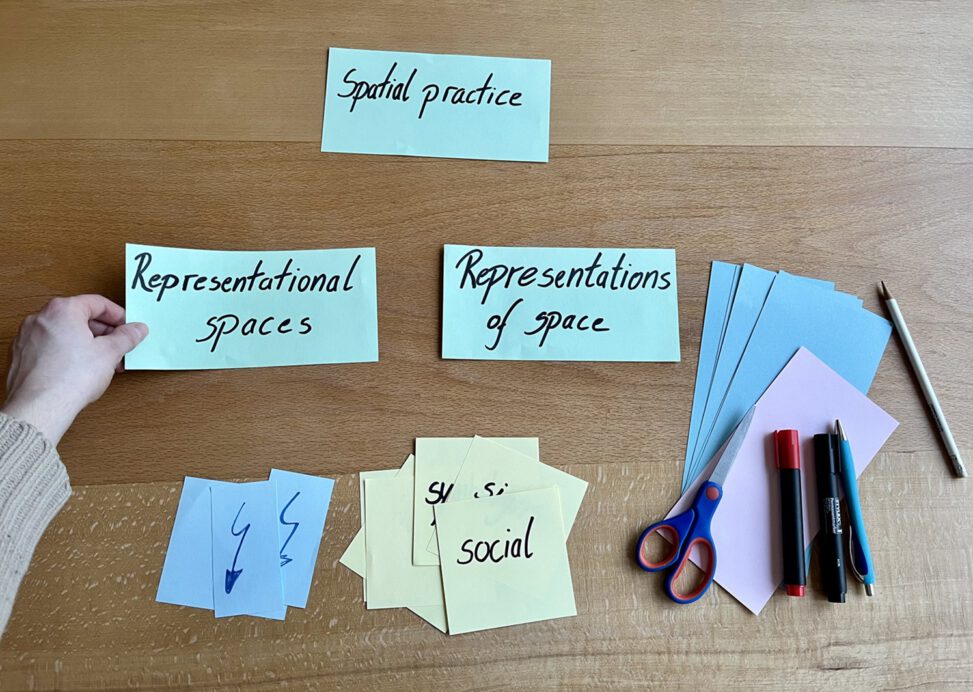Visualizing Terms and Concepts
Author:
Johanna Lehmann
Citation:
Lehmann, Johanna (2024): Struktur-Lege-Technik (Structure-Formation-Technique). Visualising Terms and Concepts. In: VisQual Methodbox, URL: https://visqual.leibniz-ifl-projekte.de/methodbox/2024/03/21/strukturlegetechnik/
Essentials
- Approach: Mental structures are visualised and contexts/relations are created.
- Function: Reflecting on mental structures and knowledge
- Advantage: This approach serves/supports the exploration of subjective presumptions and understandings; it can be applied flexibly.
Description
The Struktur-Lege-Technik (structure laying technique or structure-formation-technique; hereafter abbreviated to SLT) is a method primarily used as part of a dialogue consensus approach in connection with the exploration of subjective theories (Scheele 1992). However, it can also be used to visualize knowledge, content, and contexts. It encourages the user to establish connections as well as comprehend and reflect upon them (Wahl 2006). At its core, the method entails writing terms or (subjective) concepts on pieces of paper and relating them to each other so that they create a structure, or a structure becomes visible. In some approaches, cards can be used to illustrate the relationships according to specific rules.
SLT was developed as a dialogical-hermeneutic procedure to study subjective theories (Dann 1992:2). It is used to structure and reflect on previously collected concepts (e.g. in contexts of teaching situations) and is often preceded by an interview or a specific situation (e.g. thematizing climate change in geography lessons). Thus, subjective theories or knowledge of the participants are reconstructed and presented visually. Subjective theories are complex cognitive concepts that are linked to structures of implicit argumentation and shape actions (Wahl 1991:54), e.g. concerning climate change or classroom behaviour.
Depending on the purpose of the research and the type of knowledge to be investigated, other approaches may have to be selected and the system of rules adapted (especially for the process which primarily concerns the relations between terms). The rules guide the process and mainly concern the relationships between the terms, such as how linked terms are placed and labeled. Dann (1992:10ff.) lists a number of exemplary methods and explains their context of origin, their system of rules as well as examples of procedures and possible uses. In addition to the Heidelberger SLT, he presents, for example, the Methode zur Erfassung der Alltagstheorien von Professionellen (Method for the Assessment of Everyday Theories of Professionals; MEAP) and the Weingartner Appraisal Laying Technique (WAL). Three different variants are shown below, all of which have the flexible arrangement of cards in common. The first variant is part of the dialogue consensus method, the second variant was introduced by Wahl (2006) to make semantic networks visible, and the third variant serves the purpose to form and organize research questions (trace reading).
SLT has many functions in the context of dialogical hermeneutics (Dann 1992:3ff.), in which the potential of the method is also expressed. A structure becomes clear, comprehensible, and precise, which enables the (re)construction of knowledge. Furthermore, the method has advantages in its immediate visualization without processing steps and in the flexibility/correctability of the structural image. It enables an interpretative description of actions as well as a verification of subjective theories and forecasting of resulting actions. In addition, the method offers the possibility of stimulating change in actions through reflection and reconstruction. This is achieved by forming the structure, but also by discussing the network of terms and its implications while forming the structure and afterwards.

Image 1: SLT to organize knowledge of the Theory of Production of Space (Lehmann 2020)
Procedure Variant 1: SLT as part of the dialogue consensus method
The dialogical-hermeneutic method is based on a dialogue between a researcher and a subject (person) with the (self-)interpretation and reflection of actions at its heart. SLT in this context is used to visualize and reconstruct subjective theories. The main tool is the building of the structure to reach a dialogue consensus between researcher and researched person(s) (Dann 1992:3). To achieve this goal, it is assumed that people communicate, speak, can reflect their actions, and can be possibly rational (Horn & Schweizer 2015:67).
The following procedure is a composite of different SLTs in the context of the dialogue consensus method to research subjective theories (Dann 1992, Drieling 2015, Kindermann & Riegel 2016, Mittrach & Meyer 2020). By speaking about the structures laid out, understanding can be validated (Mittrach & Meyer 2020:5). The whole process can be documented via audio, pictures, notes, and/or video. While performing the method and afterwards, subjective theories of the subject of investigation can be analysed by the structure and argumentation which is shown by the SLT.
Preparation
- Basis: guided interview, observed situation, …
- Material: paper strips/cards; pencils; rule cards
- Choosing method and rules (e.g. Scheele & Groeben 1979:14ff.)
- if necessary, prepare cards explaining relations (according to rules), maybe reduce them for the research purpose, e.g.: lead(s) to, or, and, in order that, generic term
- present the rules to the subject
Procedure
- Writing down important terms and concepts on the cards (by researchers or research subject)
- Laying out the structure (putting cards/terms in relation)
- reconstruct recognized structures from the interview or the situation (by researchers) and/or
- have the researched person create or change the structurecards can be adjoined, grouped, or connected; relation cards can either be added or the relative distance between the cards shows the connection between the terms
- cluster-cards can be added to group terms with a heading
- the structure can be changed at any time by placing the cards differently or removing/adding cards
- Talking about the structure (while laying out the structure and after; can be recorded if necessary)
- (let) explain the structure
- ask questions for understanding, talk about contradictions
- validate the structure
- Analysing
- analyse and interpret the structure (and cluster cards) as well as the process (together or by the researcher or the subject)
- Reflecting on and maybe changing the actions (which were based on previous subjective theories)
Procedure Variant 2: SLT to make semantic networks and knowledge visible (based on Wahl 2006)
This variation can be used as a learning method or to organize (pre-)knowledge. Because of the visualization and verbalization, terms and knowledge can be connected, added and organised (Wahl 2006:183f.).
Material: paper strips/cards; pencils, scissors
- Preparing of Cards: teacher, students, or other individual persons write terms on individual cards (ca. 20; more than 30 can be confusing)
- Sorting task (if necessary): sort cards by need of clarification and discuss them with a partner
- Forming of a structure/Organizing knowledge
- lay out the cards so that they show what belongs together in terms of meaning and relation
- add arrows if necessary (the structures/arrangements can be very different for different people: with/without hierarchy upper/lower terms, rows, columns, circles, nets…)
- not the type of emerging structure is important, but the intensive discussion and the ability to justify the decisions behind the resulting structure
- Verbalizing the structure by presenting and justifying the structures to others (for example to a partner, a group or the whole class)
Procedure Variant 3: SLT to form and organize research questions
The method of trace reading supports an aesthetic and scientific access to the world (Dickel & Lehmann 2020:52;55). Traces are found by perception of the environment. They draw attention to themselves by disturbing our habits of perception and by irritating us. A trace is something we notice and which remains unclear until we act upon it, e.g. when something changes in our environment, but we don’t know exactly what. They have a materiality but a meaning is not yet inscribed, it is brought forward by reading the traces. We can use these traces to develop proper research questions; in the following it is shown how a variation of SLT can be used to develop such research questions and topics with trace reading (based on Dickel & Lehmann 2020:51f.).
Material: paper strips/cards; pencils
- Collecting traces: write down irritations, thoughts, feelings, and perceptions
- Discussing traces: discuss the traces in a group, listen to each other, and discuss similarities and differences in the previously collected impressions
- Presenting traces:
- discuss (in a plenum) which topic or question the traces point to, write them down,
- place all cards at an appropriate distance depending on the proximity and distance of the card terms in relation to the content or topic on other cards
- Saving additional traces:
- while discussing the traces and structure there may be something else that irritates
- add further thoughts and ideas to the structure:
- Structuring the research work
- discuss and select the traces/structures you want to follow,
- develop a research question based on the traces
Requirements
Depending on the approach, one or several people can take part in the method. Conditions should enable participants to talk about the structures created (both during the activity as well as afterwards, which can also change things again). Only pieces of paper and a pen are needed. The basic method requires no special software or similar tools, although a digital format is certainly possible.
Evaluation
SLT can be applied to research subjective theories or to structure knowledge and reflect on it in research and teaching environments (e.g. schools). Because of its immediacy and flexibility, the method can be performed quickly (depending on use and aim). Furthermore, it does not need any special resources and involves no additional costs.
Examples
Variant 1: SLT as part of the dialogue consensus method
- For an example of the use of SLT to investigate conceptions of pupils concerning soil, see Drieling (2015).
- For an example of the use of SLT to investigate subjective conceptions of teachers concerning social transformation, see Mittrach & Meyer (2020).
- For an example of the use of the Heidelberger SLT to investigate subjective theories of teachers regarding concept-oriented geography-lessons, see Horn & Schweizer (2015).
Variant 2: SLT to make semantic networks and knowledge visible
- For an example of the use of SLT to make knowledge (in this case about earthquakes) visible in geography lessons, take a look at Hepp (2016).
Variant 3: SLT to form and organize research questions
In a seminar for teacher-students of geography, the students were searching for interesting (geography) research questions concerning Mutiny on the Bounty-films. In order to generate proper research questions, they followed the search for traces in seven steps (Spurensuche in sieben Schritten; Dickel & Lehmann 2020: 51f.). A part of this method can be considered a variant of SLT. The students watched the movies and noted all irritating moments as well as thoughts, feelings, and perceptions (traces) (1st step). The next step was to present the traces in small groups and discuss the similarities and differences without putting them into context yet (2nd step). With the whole class, they presented all their traces, discussed them and wrote the traces and topics down on cards. The students placed the cards in a structure depending on the proximity and distance regarding topic and content (3rd step). At this point, they could add some additional thoughts and ideas (4th step). Afterwards they chose a trace, specified the theme and developed a research question (5th step). This was the groundwork for a research paper (6th step), which took the real interest of the students, developed through the traces presented to them, as a starting point. This method had the potential to start the research process, based on the perceptions of the students and their very own irritating moments. They developed questions which probably would have been left unrecognized if had the traces not been visualized and discussed beforehand.

Image 2: SLT for creating research questions concerning the Mutiny on the Bounty films (Lehmann 2018)
Suggested Tools
- paper strips/cards; pencils
- scissors
- rule cards
References
Dann, H.-D. (1992): Variation von Legestrukturen zur Wissensrepräsentation. In: Scheele, B. (Ed.): Struktur-Lege-Verfahren als Dialog-Konsens-Methodik. Ein Zwischenfazit zur Forschungsentwicklung bei der rekonstruktiven Erhebung subjektiver Theorien. Münster: Aschendorff (Arbeiten zur sozialwissenschaftlichen Psychologie, 25), 2–41.
Dickel, M. & J. Lehmann (2020): “Meuterei auf der Bounty”. Der Spielfilm im Geographieunterricht. In: Dickel, M. & M. Kowasch (Ed.): Geographien Ozeaniens. Fachliche Annäherungen und Didaktisierungsvorschläge. Praxis Neue Kulturgeographie. Münster: LIT, 41-60.
Drieling, K. (2015): Schülervorstellungen über Boden und Bodengefährdung. Ein Beitrag zur geographiedidaktischen Rekonstruktion. Zugl.: Ludwigsburg, Pädag. Hochsch., Diss., 2014. Münster: Monsenstein und Vannerdat (Geographiedidaktische Forschungen, 55). (online: https://www.uni-muenster.de/imperia/md/content/geographiedidaktische-forschungen/gdf_55_drieling.pdf)
Hepp, K. (2016): Erdbeben in Neapel – eine Region unter Spannung. Filme analysieren mit der Strukturlegetechnik. – Geographie heute, 37 (2016) 328, 40-44.
Horn, M. & Schweizer, K. (2015): Struktur-Lege-Technik (SLT) – eine Dialog-Konsens- Methode zur Erfassung subjektiver Theorien von Lehrerinnen und Lehrern. In: Budke, A. & M. Kuckuck (Ed.): Geographiedidaktische Forschungsmethoden. Berlin, Münster: LIT, 65-85.
Kindermann, K. & U. Riegel (2016): Subjektive Theorien von Lehrpersonen. Variationen und methodische Modifikationen eines Forschungsprogramms. In: Forum: Qualitative Sozialforschung (FQS) 17 (2), Artikel 1. (online: https://www.qualitative-research.net/index.php/fqs/article/view/2486/3971).
Mittrach, S. & C. Meyer (2020): Subjektive Theorien von Geographielehrkräften zur gesellschaftlichen Transformation – zum Potenzial der textilen Kette für eine „Transformative Literacy“. In: Hemmer, M.; A.-K. Lindau; C. Peter; M. Rawohl & G. Schrüfer (Ed.): Lehrerprofessionalität und Lehrerbildung im Fach Geographie im Fokus von Theorie, Empirie und Praxis. Ausgewählte Tagungsbeiträge zum HGD-Symposium 2018 in Münster. Münster: readbox publishing (Geographiedidaktische Forschungen, 72), 263–276. (online: https://www.uni-muenster.de/imperia/md/content/geographiedidaktische-forschungen/pdfdok/gdf_72_-_hemmer_et_al._-_lehrerprofessionalita__t_und_lehrerbildung_im_fach_geographie.pdf).
Scheele, B. (Ed.) (1992): Struktur-Lege-Verfahren als Dialog-Konsens-Methodik. Ein Zwischenfazit zur Forschungsentwicklung bei der rekonstruktiven Erhebung subjektiver Theorien. Münster: Aschendorff (Arbeiten zur sozialwissenschaftlichen Psychologie, 25).
Scheele, B. & N. Groeben (1979): Zur Rekonstruktion von Subjektiven Theorien mittlerer Reichweite. Univ. Heidelberg, Psychol. Inst., Bericht Nr. 18. (online: https://www.psychologie.uni-heidelberg.de/institutsberichte/DP/DP18.pdf)
Wahl, D. (1991): Handeln unter Druck. Der weite Weg vom Wissen zum Handeln bei Lehrern, Hochschullehrern und Erwachsenenbildnern. Weinheim: Deutscher Studien Verlag.
Wahl, D. (2006): Lernumgebungen erfolgreich gestalten. Vom trägen Wissen zum kompetenten Handeln. Bad Heilbrunn: Klinkhardt. (online: https://swbplus.bsz-bw.de/bsz256106703rez.htm)



Leave a Reply